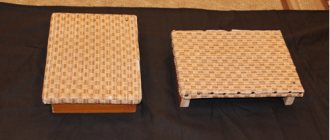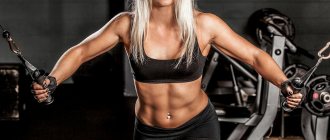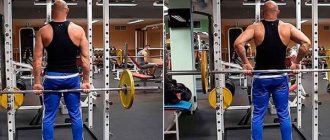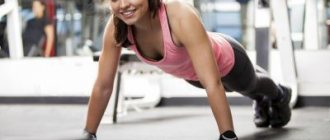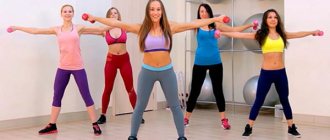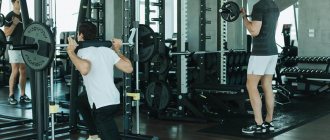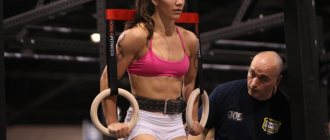Greetings to all lovers of sports, health and beauty. Today we will look at one of the best methods of losing weight, which for several decades has been helping men and women create a sculpted and aesthetic body. Step cannot be called the most popular form of fitness, but it provides perhaps the best aerobic exercise possible. Moreover, step aerobics is absolutely safe for health. It suits everyone and has a number of important advantages.
If you want to expand the boundaries of your training capabilities, lose excess fat, increase endurance and create an aesthetically pleasing body, then this article is for you. In it we will study in detail what step aerobics gives, how it differs from other types of aerobics and what are its main advantages.
What it is
Step aerobics is a type of sports aerobics. Its mandatory element is performing movements on an elevated platform. Most often, a step platform is used for this, although in practice it is easily replaced with any convenient analogue (from a coated wooden frame to a concrete block with any shock-absorbing surface). During training, the change in height plays a key role: it creates additional stress on the muscles. To do this, a series of alternating steps are performed with many variations.
The main condition for step is that the platform for training is stable and does not have sharp corners. I want to immediately dispel one myth. Step as a type of training, despite its name, is not directly tied to the platform. This is more of a marketing ploy than a mandatory requirement.
Nevertheless, the platform is the most convenient and suitable for training. Therefore, if you attend group classes at the gym, in 99% of cases the classes will be held on a step platform. It can be easily replaced at home, although for reliability I still recommend purchasing a simulator over time. You can also perform other exercises on it, such as push-ups.
The training takes place in a cyclical manner. Athletes perform exercises alternately or in series. This type of aerobics is characterized by high intensity, minimal rest and almost complete absence of contraindications.
Brief history of origin
Gene Miller is considered the creator of tap dance. In 1989, after a knee injury, she was forced to look for alternative types of training. This is how step aerobics appeared. Jean Miller herself used a regular wooden box, which allowed her to perform steps. This type of training has shown extremely high effectiveness in strengthening leg muscles, which prompted Miller to create an entire branch of aerobics based on this type of movement.
Step aerobics was incredibly popular in the 90s, as well as in the first half of the 2000s. Later it was replaced by other forms of fitness. The fashion for it returned in 2014-2015, when functional and practical types of physical activity came first.
What is step aerobics?
Step aerobics is a high-intensity type of aerobics using a step platform. Performing a combination of basic steps on a platform, in the form of dance sequences, strengthens the cardiovascular system, improves muscle tone, speeds up metabolism, and burns subcutaneous fat.
Step aerobics appeared in the 1980s, when classical aerobics was at the peak of popularity, fitness trainers Gene Miller and Kelly Watson developed dance moves using a step platform, which are still used in all clubs today. Stepping up to the rhythm of music at a high speed, suitable for burning fat, will provide a workout for the entire body, improving overall fitness and well-being. Step aerobics classes will help you lose weight and strengthen your muscles even at home.
However, aerobic exercise may be too intense and puts a lot of stress on the heart, so consult your doctor before starting.
The intensity of the workout is determined by the speed of the music; the optimal tempo is 135 – 145 beats per minute. Sometimes, an advanced level of load can reach a rhythm of 150 beats. But this pace can be dangerous for beginners.
The essence and meaning of training
Despite its simplicity, the step platform allows you to significantly diversify classic aerobics. The essence of training is to perform high-repetition intense work with minimal rest. To a large extent, step is a pure aerobic exercise, although in fitness there are groups that combine step aerobics with strength exercises. Dumbbells are used for this.
The basis of step is rhythm. Although step as a dance discipline and step as a type of aerobics are different concepts, careful adherence to the rhythm is mandatory. In step, all movements are divided into parts. These are the building blocks of the exercises. The basic "step" involves four beats, although more complex movements are performed on 8 beats. Many exercises include 32 beats, although this condition is not considered a rule, it all depends on the individual trainer. In advanced groups, the movements can be made even more difficult by adding half beats, but these exercises will require experience.
The duration of the workout is usually 20-40 minutes depending on your fitness level. In fitness clubs, classes are conducted in a group format, from 4 to 20 people (20 is the maximum group size).
Types of platforms
A step board is a wide, short, low bench, the dimensions of which can be adjusted individually, which can be carried and placed wherever you want. Its height varies depending on the required loads, the intensity of which is individual, depending on the taste or physical fitness of the person.
A step platform is a stand raised above the floor, used for support while stepping on or off it. The intensity of the loads is regulated by the height of the step. The height of the step platform for beginners should be 10-15, for experienced athletes - 20-25 cm. The platform for aerobics should have an anti-slip coating, the best of which is considered to be corrugated rubber; it will 100% prevent your feet from falling or slipping. But plastic step platforms for fitness are more common on sale; they are cheaper. If desired, you can easily make a step platform with your own hands.
What muscles work
An analysis of the exercises and movements used in step aerobics shows that this type of sports activity involves all the muscles of the body, including the neck, forearms and other muscle groups that are rarely paid attention to in aerobics. The main load falls on the muscles of the lower body, back and abdomen. The shoulders are also involved in the work, especially with various types of arm swings. Step aerobics often includes strength training, using lightly weighted dumbbells.
Rules for working with the step platform
In order for exercises on the steppe to benefit the body, you must follow the following rules for working with equipment:
- Your back should be straight while doing the exercises.
- Climbing onto the apparatus is carried out using the leg muscles.
- The entire foot is placed on the surface of the board; there should be no sagging of the heel or toes.
- You only need to exercise in comfortable non-slip shoes.
- You are allowed to stick your butt out when doing squats.
- You cannot jump or lower yourself to the floor with straight, tense legs.
- Movements should be fast, but not intermittent.
This type of sports activity is beneficial for the cardiovascular system, for improving coordination, balance, stability, endurance and elevating mood.
To practice step aerobics, you do not need to have special physical training, because every person can move up and down the steps. During training, walking on the “step” will alternate with jumping and squats. Even those who didn’t like these standards at school are happy to stomp and jump to the music. And losing 4 kg of excess weight from the body in a month will please any athlete.
Moreover, you don’t need to go to the gym specifically to practice the step; you can buy this equipment and practice sports on it at home. The projectile does not take up much space.
Kinds
There are 4 main types in the steppe. Each of them differs in the intensity and complexity of the training programs. Often, trainers make certain changes to step aerobics, designating the complex as a “separate technique,” often with its own name or surname. I want to disappoint: this is nothing more than the personal ambitions of the coach.
Sometimes such a distortion of the essence of step can be useful, for example, a power step (a combination of strength and aerobic movements in step), but more often the situation is the other way around. Therefore, it is better to avoid such “innovations” in the steppe. Among the official types are:
- Step-basics. Basics with the easiest movements. The training is short, this type is necessary to prepare the muscles, respiratory and cardiovascular systems for subsequent loads. The course allows you to remember the basic concepts in step, the names of exercises, develop rhythm, etc.
- Step 1. Classic training. The first stage is for trained people and the second for beginners (who have previously completed the basics). The overall intensity, duration of training and load increase.
- Step-comb. A more complex type of step. Includes various combinations of exercises, complex movements and long series. Requires experience, not suitable for beginners.
- Step-interval. Alternating different types of load. It is mainly a combination of strength and aerobic movements, but interval step also adds plyometric exercises and even statics.
Types of exercises
For each person, you can individually combine a set of exercises, and there are more than 200 types of steps, ascents and descents from the platform. Every 5 cm of additional step height leads to an increase in load by 12%. For each level of load, according to your capabilities, you can find a lot of video lessons if you plan to train on your own and not under the guidance of a fitness trainer.
A standard workout with a step platform lasts approximately 45 minutes (maximum 60 minutes) and consists of several stages:
- Warm up, 5 minutes. With a small load, the muscles warm up.
- Pre-stretching – designed to “wake up sleeping” thigh muscles and other muscles with ligaments, 5 minutes.
- The main part (aerobic). This is a minimum of 35 minutes of work with the step platform.
- Cool down, at this stage the heart rate and breathing calm down, 5 minutes.
For beginners, the main part of the workout should last at least 20-30 minutes, for advanced ones - 40-45 minutes. This time is enough to get enough physical activity to lose weight.
Step has several levels of difficulty. Low-intensity step aerobics for beginners is not suitable for experienced amateurs; intense training is intended for them. They differ in the complexity of the steps and the duration of the aerobic part. At the very beginning, step aerobics without a platform is allowed.
Any activity will make you sweat a lot, so you should drink 500 ml of water 30-60 minutes before it starts. During training, every 15-20 minutes you need to take several sips to quench your thirst. Those. A bottle of clean water should always be at hand.
For newbies
If you have no idea what regular exercises with a step platform for weight loss are, start with basic movements. These are basic step aerobics steps with a minimum of turns. The first level is called basic step. In order to have vigor and slimness as a result of exercise, and not injury and fatigue, the workouts must be designed correctly. Then step aerobics will beneficially correct posture, improve joint health, and prevent arthritis with osteoporosis and other diseases that develop with a lack of movement.
For experienced athletes
The next most advanced level of exercise is Step Advanced. These are already steps with links; there are two directions here: Dance and Power.
In the first case, complication occurs due to dance movements, which can reach serious choreographic ones. This type of training is suitable for those who love clubs and dancing.
The second type of exercise is a combination of aerobic exercise with strength exercises. In this case, a deep study of the muscles that need to be tightened and strengthened is achieved. The strength component of each workout takes an additional 15 minutes. But most professional trainers refuse power step aerobics. It includes push-ups, abdominal exercises, etc., as a result of this complex, up to 600 kilocalories are burned in each session. Therefore, even for experienced athletes, the benefits of step aerobics are undeniable.
Indications and contraindications
The list of indications for steppe is very long and includes almost all points for which physical activity is indicated. This is not just a workout for weight loss, but a completely balanced type of physical activity that is suitable for a wide range of people. The main indications for step training include:
- Weight correction.
- Increased endurance and strength.
- Cardiovascular training.
- Development of movement coordination.
- Correction of posture.
- Strengthening the musculoskeletal system.
- Increased muscle tone.
- Treatment of various diseases (insomnia, depression, etc.).
- Strengthening the immune system.
Step aerobics is often recommended for people with various cardiovascular diseases. Without excessive zeal and subject to the required intensity of training, this type of physical activity significantly improves the condition of blood vessels and normalizes blood pressure.
Clear contraindications include:
- Osteoarthritis of the knee joints.
- Phlebeurysm.
- Herniated intervertebral discs.
- Chronic liver and kidney diseases.
- Cholecystitis at the acute stage.
- Ongoing inflammatory processes or elevated temperature.
Contraindications to step aerobics classes
There have been studies that show that step aerobics exercises are good for your joints and can make them stronger. But this only applies to healthy people. For people who already suffer from problems with the spine and joints, such as osteoporosis, hernias, protrusions, inflammatory processes, jumping loads can do more harm than good. High-intensity exercise with high blood pressure is also contraindicated, since aerobics can increase it; hypertensive patients should avoid high-level cardio exercises.
Benefits and harms
Let's look at the pros and cons of step as a type of aerobics. I will take into account all directions, that is, both aerobic and strength styles, which equally apply to step. Let's start with the advantages:
- Involves all muscles of the body.
- Great for increasing endurance.
- Improves coordination and balance.
- Strengthens the musculoskeletal system.
- Effectively burns fat.
- Increased load on the back and abdominal muscles, which helps improve posture.
- The cardiovascular and respiratory systems are trained.
- Immunity is strengthened.
Let me clarify how step aerobics is useful in terms of muscle development. We are talking about harmonious and natural improvement of muscles. You will never be able to pump up the same volumes with step aerobics as in bodybuilding. This is more of a choice for those who need relief rather than volume. Training gives mobility, develops coordination and ensures all-round development.
This type of aerobics also has its drawbacks. The first is conditional, it concerns the absence of a profile load. But if you need health training or aerobics for weight loss, this will not be a minus. But the load on the knees that occurs when working with a step platform is the main drawback. It can be leveled out a little by training in special groups with reduced load, but this will not allow you to progress.
Is it possible for children to study
There are no direct restrictions on training children in steppe. You can often see children's sections in fitness clubs, although it cannot be said that they are incredibly popular. Almost all roads are open for children in choosing sports disciplines and types of training, and it is fair to consider steppe to be far from the best choice. It trains endurance well, can remove excess fat, tone muscles, but will not provide powerful development in terms of specialization.
Therefore, if you choose between the options “sit at the computer” and “sign up for a step class,” I definitely recommend that all parents choose the second option. In other cases, it is better to find out how interested the child will be in step.
How to practice at home correctly
One of the advantages of this type of aerobics is home workouts. You can exercise at home with the same effectiveness. To do this, you only need a step platform and a pair of dumbbells. I advise you to take collapsible ones, because over time you will have a desire to grow and increase the weight of the weights. Let's look at everything in order.
Necessary inventory and equipment
For training, you only need a step platform and comfortable clothes. The platform can be replaced with improvised means, but I advise you to take this as a temporary option. In order to practice step properly, it is still better to purchase a simulator specially equipped for this, and it is also inexpensive. I also recommend getting a pair of collapsible dumbbells for alternating step with strength exercises.
No special shoes required. Regular fitness sneakers with foot cushioning are sufficient. For more professional training, models with ankle support are better suited, although you should not buy such sneakers right away: they can cause inconvenience for a beginner.
Nutrition and supplements during exercise
No special supplements are required, especially if you consume your full daily protein intake from food and your diet contains sufficient amounts of fruits and vegetables. Some supplements can speed up progression, both through direct effects and by improving the quality of your workouts. I include these:
- Protein (whey concentrate or isolate). Take only in the morning and after training.
- BCAAs. It is optimal to take the powder form, mix with water and drink throughout the entire session. Otherwise, you can get by with protein.
- Green tea extract. A good energy drink, it also improves concentration and can accelerate lipolysis.
- L-Carnitine. Ideal for aerobic training. It accelerates the utilization of fatty acids, providing not only accelerated fat burning, but also increased energy.
- Omega-3. An indispensable supplement in many cases, especially when losing weight and frequent training.
Where to start first
If you have already purchased a platform or signed up for a gym, then you should start with the very basics, that is, mastering the exercises. This implies not only mastering the technique itself, but also the ability to count, determine the leading leg and get into the rhythm. Fortunately, there shouldn't be any problems with the latter: there are thousands of special tracks written for aerobics. Next is just practice, strengthening muscles and improving endurance so that the body can withstand long-term training.
Number and duration of training
There are no special restrictions for aerobic exercise. It does not overload the central nervous system like strength exercises, so you can do it every day. Nevertheless, beginners should not forget about sore throat and muscle acidification. Optimal training is no more than 3-4 times a week. You need to turn on the power elements no more than 2-3 times a week.
The duration of the training directly depends on experience and training. Beginners are recommended to perform 20-minute sessions of intense work. At the beginning of the workout, a five-minute warm-up is performed, and at the end - stretching exercises. More advanced athletes can easily withstand 40-45 minutes of active training; this is the benchmark they should strive for. It is not advisable to train for more than 50-60 minutes; the benefits of such long training will sharply decrease. If you manage to exercise for so long, then there is only one conclusion - you need to increase the intensity.
What time to train
There is no direct connection between training and time in step, but there are so-called “efficiency hours” when classes can give the greatest effect. This is due to human biorhythms and the time of calm and wakefulness. It is optimal to train in the morning, 2-3 hours after waking up. Evening classes should be no later than 4-5 hours before bedtime. For the rest, be guided by your feelings, work schedule and other conditions.
Benefits of classes
Advantages of step:
- This is a simple lesson, the choreography is more understandable than in aerobic dance classes.
- Interval step and workouts for beginners are suitable even for those who just want to increase their calorie expenditure, but do not dance and do not intend to study.
- In an hour in a non-boring environment, from 300 to 600 kcal are burned .
- Aerobic endurance and blood circulation improves.
This is an alternative to cardio training or aerobics without platforms. Anyone can learn; lessons are available in most fitness clubs and are held almost every evening. Training without strength training can easily be integrated into a weight loss program. For example, you can do strength exercises three times a week, and take step classes a couple of times. However, do not forget about the calorie deficit, otherwise no amount of exercise will help burn excess fat.
The lesson is suitable for any level of training. The higher the endurance, the greater the amplitude of steps can be. You can place the platform at a higher level and load the heart and leg muscles even more.
You can also train at home. Several classes are available in open sources. Experienced people love to improvise to music. You can watch a good program for practicing at home in this video:
A big plus for girls who do not want to build muscle mass is that the step tone their legs and buttocks, but does not increase muscle volume.
Correct technique and basic step aerobics exercises
All movements in step aerobics (called “steps”) are divided into two categories: with or without changing the leading leg. Each category implies which foot the beat begins on. Usually movements are performed on a count, in 4 or 8 beats.
Steps without changing the leading leg include:
- Basic step.
- V-step.
- Over the top or Over.
- Turn step.
- Straddle.
All steps from the list are performed on 4 counts, except for Straddle - it will require 8 counts.
Steps that require a lead foot change:
- Tap up.
https://www.youtube.com/watch?v=_02zQx1v0VU
- Knee up.
- Step lift.
- Step kick.
- Step curl.
- L-step.
All movements are performed in 4 counts, except for L-step - it will require 8 beats. Each step element is much easier to master by studying a video with the technique. This will allow you to quickly understand the essence of the step and its features.
Effective exercises on a stepper for burning fat
Beginners are recommended to divide the training into 2 blocks:
- 1 – warm-up and strengthening the “base” (30 minutes);
- 2 – basic classes (15-20 minutes).
Once all the steps are mastered, you can increase the time of the second block and the duration of the workout itself. To lose weight, it is recommended to exercise for at least 1.5 hours 3-4 times a week, also using the upper body. Advanced athletes can use weights and additional equipment (dumbbells).
Important! A warm-up must be done first to allow the muscles to warm up well. Stretching is carried out in the form of simple aerobic steps (Step-touch), as well as elements with knee elevation. Completed within 3-5 minutes.
A set of exercises for losing weight on a stepper will include ligaments with the following steps:
- Basic Step;
- V-Step;
- Step-up;
- Curl Step;
- Step Kick
- L-step.
They can be combined in different ways, adding arm swings and body turns. Basic Step and Step-up are simple steps that can be used as a rest between ligaments. Curl Step – A basic forward step that wraps around the shin.
You can lose weight within 3-4 weeks by performing this complex under the following conditions:
- in the first week, do 3 approaches (with each step) for 2 minutes with breaks of 60 seconds;
- in week 2, perform 2 sets, spending no more than 3 minutes on each (rest interval - 60 seconds);
- in the third week - one 4-minute round and 2 sets of 3 minutes;
- for 4 – one 5-minute approach and 2 four-minute ones.
The total duration of classes will gradually increase from 1-1.5 to 2-2.5 hours. You can also add lower abdominal exercises to the complex using a step platform. This could be lifting or spreading your legs.
Examples of workouts at home
The number of programs tends to infinity, because elements can be changed, alternated or supplemented. But this requires experience, so let’s look at examples of basic training designed for athletes with different levels of physical fitness.
For beginners
- Simple step.
- Side step.
- Overlapping step.
- Knee step.
- Jumping to the side.
- Walking with high knees.
- Alternate jumps on the platform.
The training can be carried out in two formats. In the first option, the entire cycle of exercises is performed for 1 minute and repeated again. In the second option, each exercise is performed for 2 minutes, but without repeating the entire cycle.
For advanced
- Basic step.
- Alternating swings of legs with walking.
- Step with leg abduction.
- Step with knee lift.
- Mamba.
- Alternate jumps on the platform.
- Angular step.
- Step with the leg taken back.
Two circles are performed, 1 minute for each exercise. The first is without weights, on the second, a 30-second series with dumbbells of the following exercises is inserted between each exercise: bent-over rows, standing swings, biceps curls.
Reviews and results
Alya: “I went to step dance 7 years ago, when it was not particularly popular. I got very involved and trained seriously. When the gym closed, I went to a regular fitness center and for a long time was in awe of how sluggish the workouts were there. Yes, and there was not enough speed, constant work and drive. It seemed that even my stamina was beginning to wane. Then I gave up on everything and bought home a step, dumbbells, sandbags and leg weights. Now I have my own hall, created for pennies.”
Tosha: “Even though I was the only man in the group and had a lot of complexes, it was worth it. Minus 10 kg in 2.5 months without the use of additives! Trousers and jeans had to be sewn in, shirts all became useless bags. But there is no fat)).”
Photos before and after
Photos of the transformation of men and women during step aerobics classes clearly demonstrate how beneficial this type of physical activity can be.
